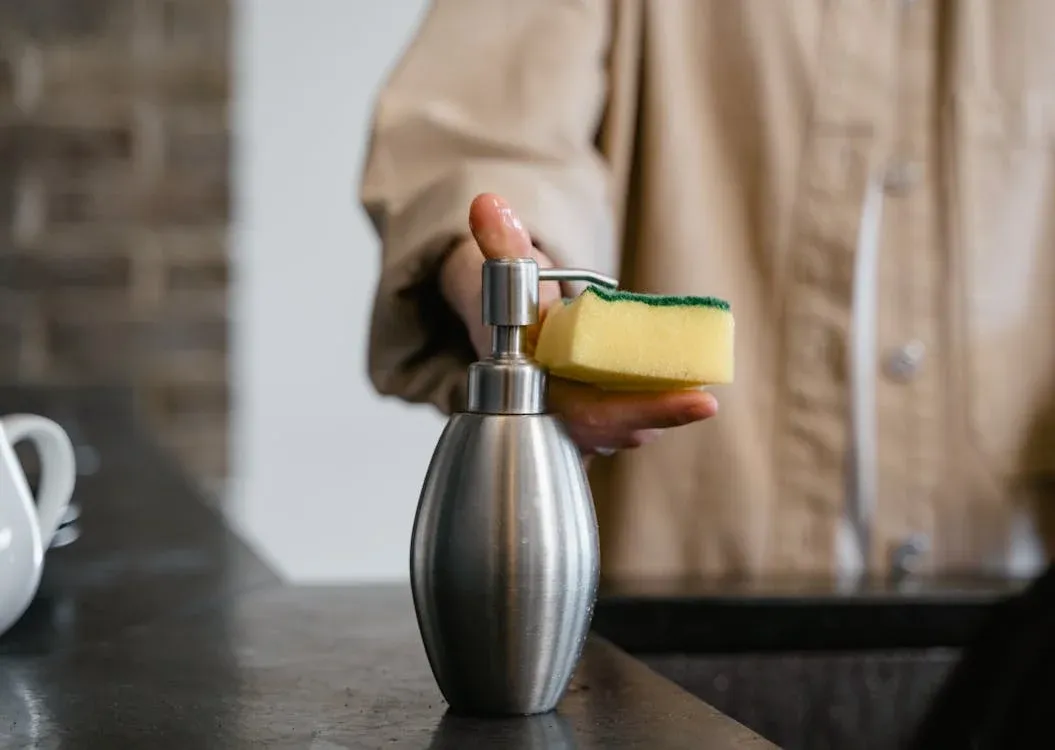Are you ready to slice and dice like a pro? Whether you're a budding chef in your home kitchen or a wild adventurer prepping meals in the great outdoors, mastering the art of meat cutting is essential. But let's face it, not all knives are created equal. From effortlessly carving through a juicy steak to finely chopping veggies, the right knife can make all the difference.
In this blog, we're diving into the world of top-notch knives that can handle just about anything you throw at them – raw meat, cooked delights, crunchy veggies, and even the toughest fruits. Get ready to discover your new kitchen sidekick!
🤝As an Amazon Associate, we earn from qualifying purchases made through our links, at ZERO additional cost to you.
6 Best Knives for Cutting Meat
- Best Overall: DALSTRONG Slicing and Carving Knife
- Editor's Choice: Zelite Infinity Chef Knife
- Best for Deboning: Victorinox Fibrox Pro
- Best for Filleting: Bubba Electrical Fillet Knife
- Best for Breaking Bones and Slicing Thick Meats: DALSTRONG Cleaver 7"
- Best Set: Jero Butcher Meat: 4 Piece Set
1. Best Overall
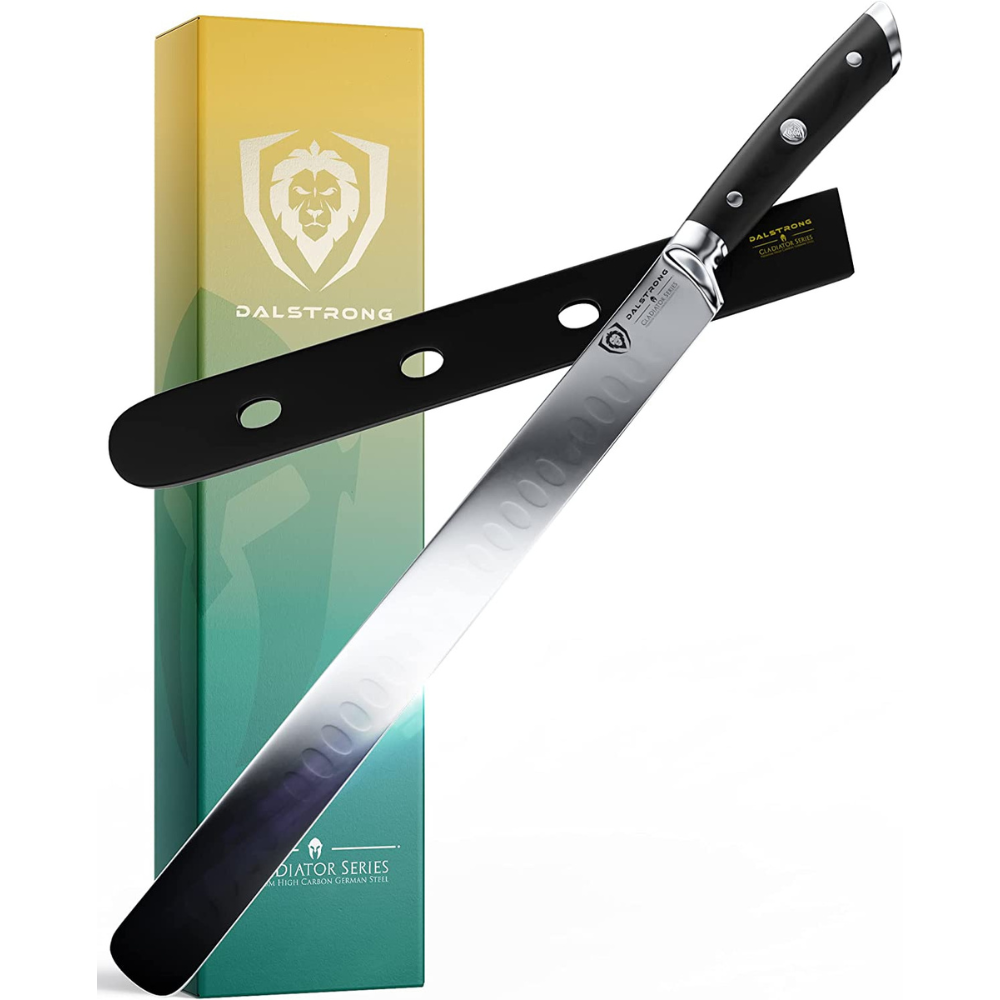
DALSTRONG Slicing and Carving Knife
This knife combines outstanding craftsmanship, cutting-edge technology, and a stunning design. It's incredibly sharp, versatile, and ergonomically designed, making it suitable for both professional chefs and home cooks. Its balance of performance, aesthetics, and durability makes it a top choice.
What We Love
- Ergonomic Pakkawood Handle: Offers comfort and ease of use.
- Curved Blade for Leverage: Facilitates smooth slicing through various materials.
- Preferred by Professionals: A trusted choice for chefs.
- 100% Money-Back Guarantee: Ensures customer satisfaction and trust.
What to Keep in Mind
- Specialized Design: May require specific skills for optimal use.
Why It Might Be Right for You
If you're seeking a knife that excels in both form and function, the DALSTRONG Slicing and Carving Knife is your ideal match. Perfect for those who appreciate the finesse in slicing and carving, this knife promises precision whether you're carving a roast or slicing delicate vegetables. Its superior craftsmanship ensures a balanced, comfortable experience, making it a versatile champion in any kitchen.
Customer Review (source: Amazon)
I'm thrilled with this gorgeous knife! After returning a competitor's slicer due to poor workmanship, spending a bit extra on this one was a great decision. Its balance and smooth handle are impeccable, and it's now a proud addition to my kitchen. It effortlessly sliced through my first rib roast like warm butter. I'm now aiming to get a complete set of these knives, reserved just for me, while my old set becomes the everyday one. Every home cook deserves a great set of knives – they make cooking fun and easier. This slicer is jaw-dropping in both looks and performance, and definitely worth the extra dollars. Happy grilling and cooking to all!
2. Editor's Choice
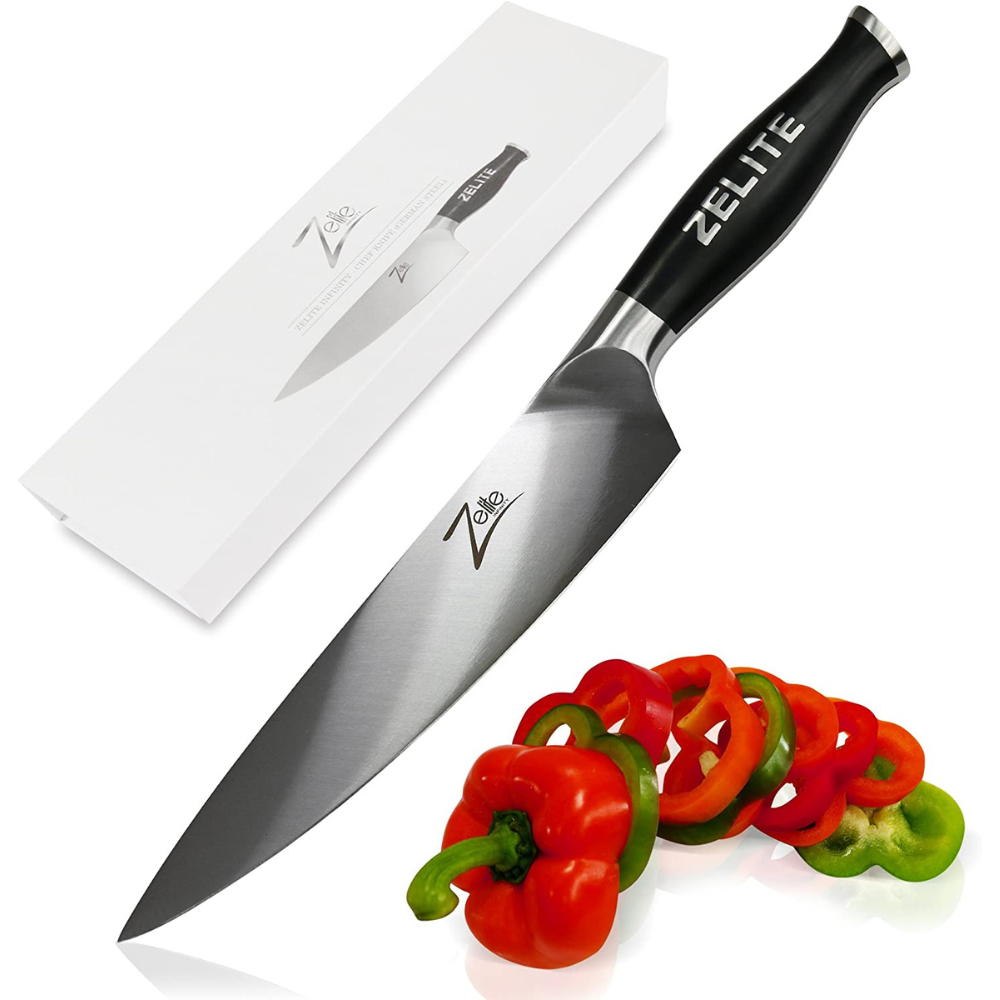
Zelite Infinity Chef Knife
The Zelite Infinity Chef Knife stands out for its exceptional quality and versatility. It's particularly noted for its razor-sharp blade and ergonomic handle, making it ideal for a variety of kitchen tasks. The lifetime warranty adds to its appeal, making it a favorite among culinary enthusiasts.
What We Love
- Lifetime Warranty: Ensures long-term satisfaction and reliability.
- Extremely Sharp Blade: Offers precision and ease in cutting.
- Effortless Cutting Experience: Requires minimal effort for slicing and dicing.
- Simple Cleaning and Care: Low maintenance and user-friendly.
What to Keep in Mind
- Designed for Skilled Users: Its larger size and sharpness are more suited for those experienced in the kitchen.
Why It Might Be Right for You
This knife is a dream for the culinary enthusiast who values precision and versatility. The Zelite Infinity Chef Knife is not just a tool, but a partner in your culinary journey, adept at handling everything from mincing herbs to slicing meats. Its ergonomic design and exceptional sharpness make it a joy to use, ensuring that every cut is a reflection of your culinary passion and skill.
Customer Review (source: Amazon)
I was hesitant about buying a chef's knife online, but this purchase turned out to be the best decision. The knife is surprisingly huge, and at first, I was nervous about using it. However, the moment I held it and started cutting, I knew it was perfect for me. The grip feels wonderful, and it glides effortlessly on the cutting board, slicing through vegetables like butter. I'm now planning to save up and buy more from this company to complete my set. I've already got the bread knife and can't wait to use it. Best chef's knife ever!
3. Best for Deboning
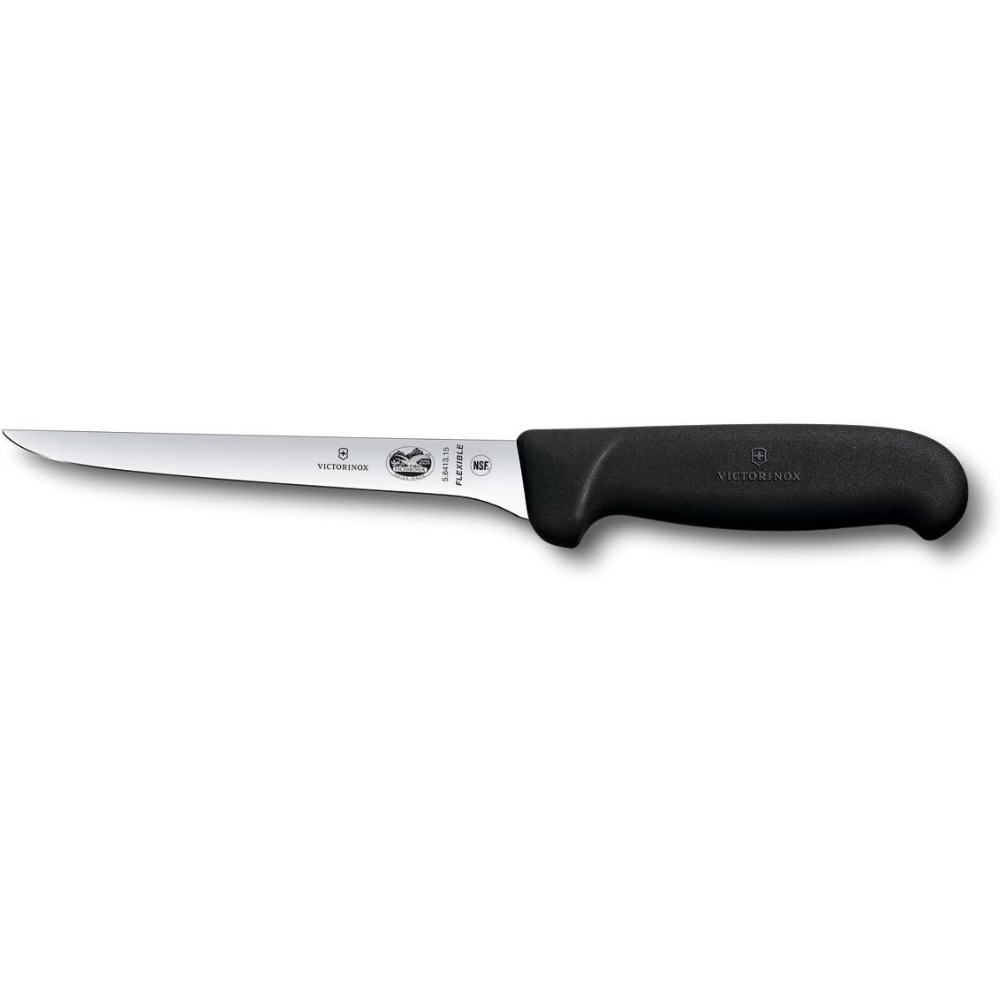
Victorinox Fibrox Pro
With its ergonomic design and incredibly sharp blade, this knife is perfect for deboning. It's affordable, yet doesn't compromise on quality, making it an excellent choice for both beginners and experienced cooks.
What We Love
- Affordability: High-quality at a price accessible for many, including those new to culinary arts.
- Ergonomic Design: Minimizes wrist tension, ideal for extended use.
- Exceptional Sharpness: Cuts through tough meat effortlessly.
- Lightweight European Steel: Offers a balance of control and durability.
What to Keep in Mind
- Regular Sharpening Needed: To maintain its superior cutting performance.
Why It Might Be Right for You
If deboning meat is a frequent task in your kitchen, the Victorinox Fibrox Pro is tailored for you. Its design focuses on control and precision, making it ideal for cleanly separating meat from bone. The ergonomic handle ensures comfort during prolonged use, making it a reliable tool for both professional chefs and home cooks who demand efficiency and precision in their meat preparation.
Customer Review (source: Amazon)
I'm really impressed with this Victorinox Swiss 6" boning knife. It's incredibly sharp, cutting through paper in a single stroke with a clean cut. The heavy-duty feel and shiny smooth texture are great, and it fits well in my small hand. It's going to be a huge help when we harvest our deer meat. The packaging was different than expected, but the knife was securely wrapped and arrived quickly. The price is very reasonable too. I'm so happy with it that I just bought another one as a spare.
4. Best for Filleting
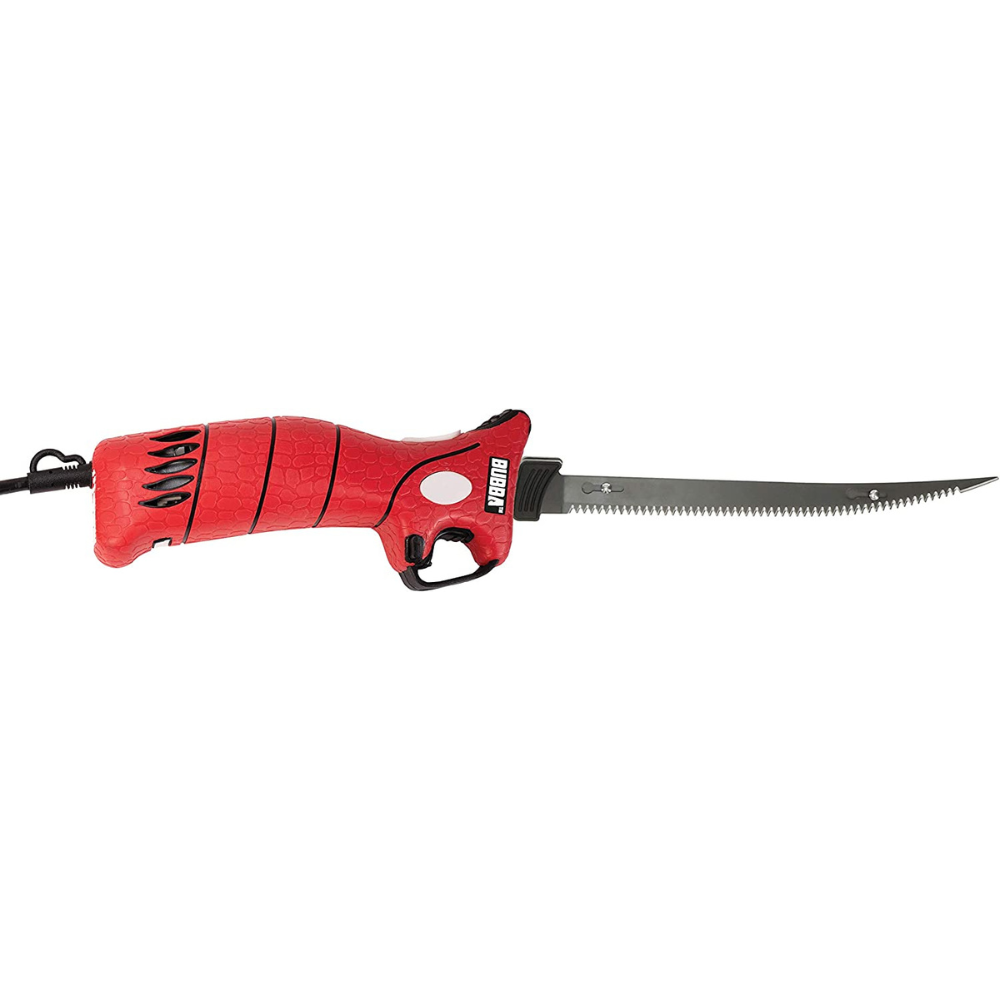
Bubba Electrical Fillet Knife
This electric knife is specifically designed for filleting, making it an ideal choice for anglers and cooks who frequently prepare fish. Its electric operation and non-slip grip handle provide ease of use and efficiency.
What We Love
- Electric Operation: Simplifies the filleting process with enhanced efficiency.
- Removable Blades: Facilitates easy cleaning and maintenance.
- Included Carrying Case: Provides convenient storage and transport.
What to Keep in Mind
- Gear Durability: The gears may wear down quickly with frequent use.
Why It Might Be Right for You
For the angler or the cook who often finds themselves filleting fish, this electric knife is a game-changer. The Bubba Electrical Fillet Knife combines power with precision, allowing you to effortlessly glide through fish, achieving perfect fillets every time. Its specialized design and electric operation make it a must-have for those who value speed and precision in fish preparation.
Customer Review (source: Amazon)
This Bubba electric fillet knife is the best I've ever used. After borrowing one from a friend, I was sold on its performance. It's a significant upgrade from the Rapala electric fillet knives I've used and worn out in the past. The ease of inserting and removing blades, along with the inclusion of four blades and a functional case, makes it outstanding. It feels more like a power tool than just a fillet knife, with so much power that cleaning fish like crappie is a breeze. I highly recommend it for anyone who fishes frequently and needs a reliable fillet knife.
5. Best for Breaking Bones and Slicing
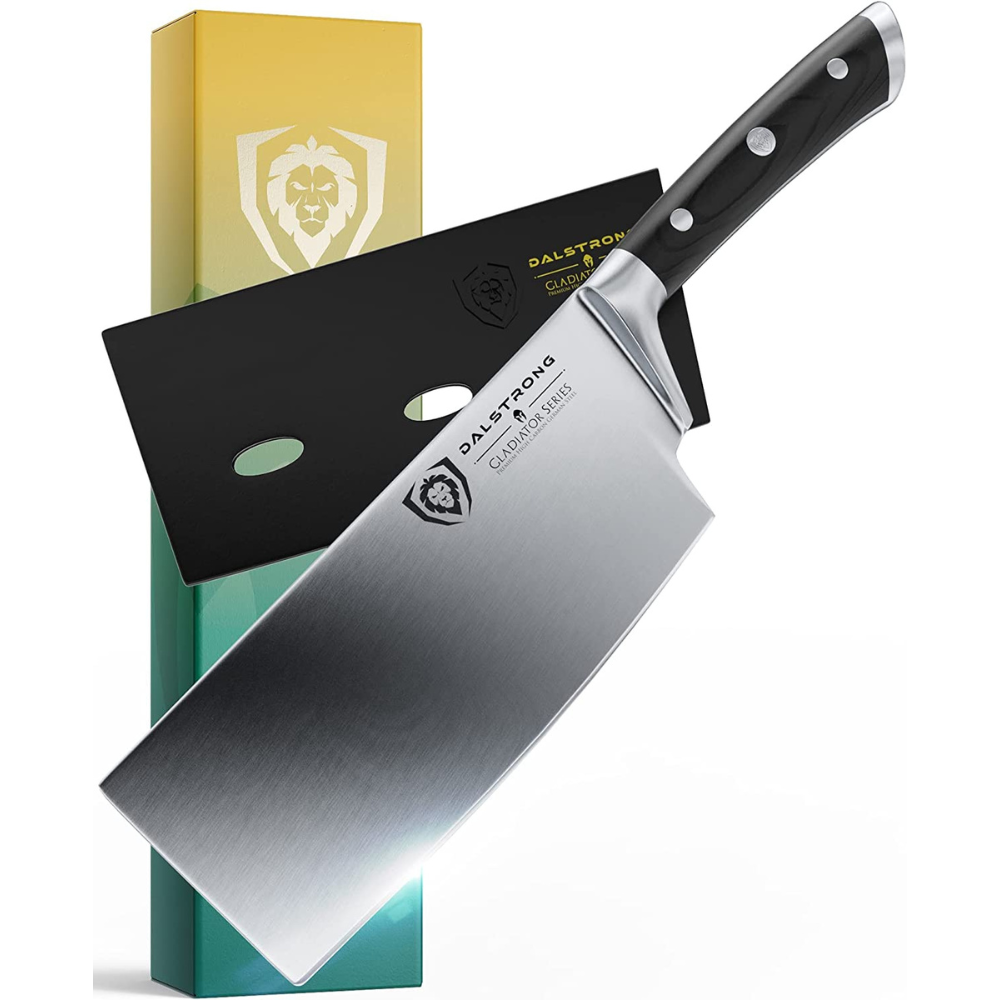
DALSTRONG Cleaver 7"
This heavy-duty cleaver is perfect for more robust kitchen tasks like breaking bones and slicing thick meats. Its ergonomic handle and high-carbon German steel blade make it a formidable tool in the kitchen.
What We Love
- Ergonomic and Ambidextrous Handle: Ensures comfortable and versatile use.
- Full-Tang Design: Offers durability and balance.
- Multipurpose Heavy-Duty Use: Ideal for breaking bones and slicing thick meats.
- High-Carbon German Steel: Ensures sharpness and longevity.
What to Keep in Mind
- Intimidating Design: Its heavy-duty and menacing shape might require some getting used to.
Why It Might Be Right for You
This cleaver is a powerhouse, ideal for those who regularly tackle challenging cuts. Whether you're breaking bones or slicing through thick meats, the DALSTRONG Cleaver 7" offers the heft and sharpness needed for these tough tasks. Its robust construction and ergonomic design make it a reliable tool for heavy-duty kitchen work, ensuring you can handle the most demanding culinary challenges with ease.
Customer Review (source: Amazon)
I bought this 7" cleaver five years ago, mainly to cut through chicken bones, but it has become the most-used knife in my kitchen. It's incredibly versatile, great for slicing meats, breaking down poultry, and dicing or mincing vegetables and herbs. The wide blade is perfect for transferring chopped ingredients into a pan or wok and even flattens veal and chicken filets well. It's well-balanced, comfortable for extended use, and the German high-carbon steel holds an edge superbly. After five years, there's no chipping or rusting, thanks to regular sharpening and careful hand washing. I highly recommend this cleaver, especially for those who can't afford a high-quality set of specialized knives. It's the most used knife in my kitchen!
6. Best Set
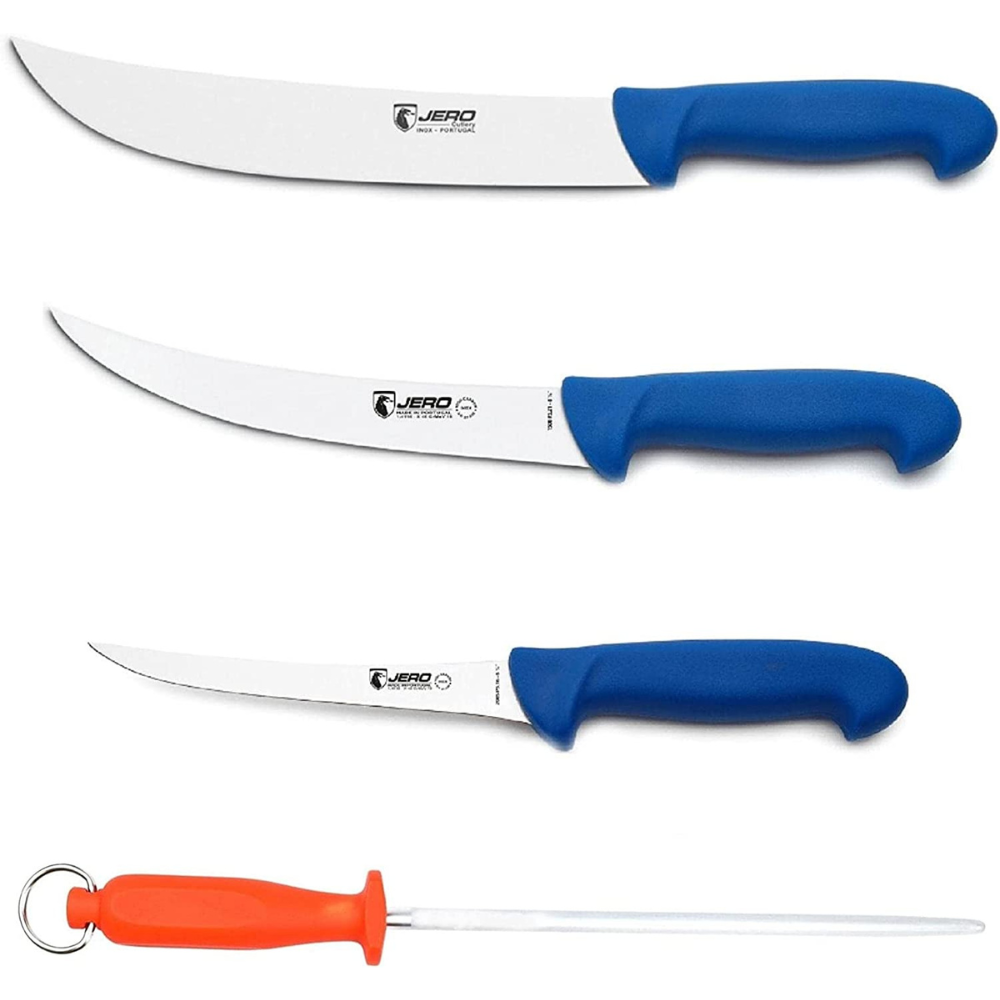
Jero Butcher Meat: 4 Piece Set
This set is ideal for those who need a complete solution for meat processing. It includes various knives and a sharpening tool, making it a comprehensive set for butchery.
What We Love
- Versatile Knife Selection: Includes a 10-inch cimeter, an 8-inch breaking knife, and a 6-inch curved boning knife.
- Quality Sharpening Tool: Ensures your knives remain sharp for efficient meat processing.
- Durable Construction: German high-carbon stainless steel blades for strength and longevity.
- Ergonomic Handles: Made from impact and temperature-resistant polymers, suitable for various hand positions.
- Professional Grade: Designed for the meat processing industry, ensuring reliability and efficiency.
What to Keep in Mind
- Specialized Use: Primarily designed for meat processing, which may not suit all kitchen needs.
Why It Might Be Right for You
For those who need a comprehensive solution for meat processing, this set covers all bases. From breaking down large cuts to precise boning, the Jero Butcher Set equips you with the right tool for every step of the process. Its variety and quality make it perfect for both professional butchers and home cooks who take their meat preparation seriously.
Customer Review (source: Amazon)
I bought these meat carving knives for my son and his wife as a Christmas gift. They haven't used them much yet, but they've told me the knives are of good quality metal, maintain a sharp edge, and slice through meat easily. They love them! Now, I'm thinking I might have to get a set for myself too. :)
How We Chose Our Top Picks
Our aim is to provide you with expert, well-researched insights into the best meat knives available. We understand the importance of a reliable knife in the kitchen and are here to guide you through your choices.
Research and Customer Reviews
Our team has thoroughly researched each knife, analyzing its features, materials, and craftsmanship. We've also examined customer feedback from sources like Amazon to understand how these knives perform in real-world settings.
Comparative Analysis
We compare each knife against its competitors, focusing on factors like quality, versatility, and value for money. This helps us identify the unique strengths and potential limitations of each product.
Selection Criteria
Our top picks are chosen based on quality, performance, and user satisfaction. We recommend knives that excel in sharpness, durability, and ease of use, ensuring you get the best tool for your culinary needs.
Our Commitment
We're dedicated to helping you find the perfect meat knife, whether you're a professional chef or a home cook. Our reviews are designed to be informative and unbiased, guiding you to make a well-informed decision for your kitchen.
Buyer's Guide
Every knife has its tale and purpose in the culinary world. Let's delve into the types specifically crafted for meat, each with its unique flair and function.
Meat Cleaver: Think of the meat cleaver as the heavyweight champion of the kitchen. With its broad, rectangular blade, this knife is a force to be reckoned with. It's designed for heavy-duty tasks like butchering, effortlessly cutting through bones and thick cuts of meat. Its heft and size make it a formidable ally in processing raw meats.
Carving Knife: Elegance meets precision in the carving knife. Sporting a long, slender blade that tapers to a fine point, this knife is all about creating clean, uniform slices. Whether carving a roast or portioning a chicken, its design ensures beautifully presented meat. Beyond meat, it's versatile enough for slicing fruits and vegetables too.
Fillet Knife: Close cousin to the boning knife, the fillet knife boasts a long, flexible blade, perfect for handling delicate tasks like deboning fish. Its design allows for precise skin removal and minimal damage to tender meats, making it a seafood lover's dream.
Boning Knife: The boning knife is the epitome of finesse in meat preparation. Characterized by its slender, upward-tapering point and curved blade, this knife is all about agility. Ideal for removing bones and trimming fat, its flexibility allows for intricate work without compromising the meat's integrity.
Beyond Meat: Versatile Kitchen Companions
While the above knives are meat-centric, let's not overlook the all-rounders that can lend a hand with meat prep too.
Paring Knife: Small but mighty, the paring knife is your go-to for delicate tasks. Its compact size is perfect for intricate work on fruits, vegetables, and herbs, and it can be surprisingly effective for making precise cuts in meat.
Chef's Knife: The chef's knife is the jack-of-all-trades in your knife arsenal. With its broad, slightly curved blade, it's built for a range of tasks, from chopping veggies to slicing meat. It's the versatile hero every kitchen needs.
Utility Knife: A smaller sibling to the chef's knife, the utility knife shines in handling smaller tasks. It's great for fruits and vegetables but can also step up to the plate for slicing meat when called upon.
Forged Knife Versus. Stamped Knife
When it comes to kitchen knives, the debate between forged and stamped varieties is as old as the tools themselves. Each type has its unique characteristics, strengths, and weaknesses. Let's dive into what sets them apart and how they can impact your culinary experience.
Forged Knives: A forged knife is akin to a piece of art, crafted from a single piece of metal. The process involves heating a piece of steel and then molding it into the desired shape. This technique results in a robust and durable knife, characterized by a bolster – a thick junction between the handle and the blade. This bolster not only adds strength but also provides balance, making the knife easier to handle.
The handle of a forged knife is typically attached with rivets, ensuring a secure and long-lasting bond. The seamless construction from blade to handle means less risk of breakage, offering a reliable tool for your kitchen endeavors.
Stamped Knives: In contrast, stamped knives are born from a more industrial process. They are cut out from large sheets of steel using high-precision machines. This method is more cost-effective and allows for mass production, making stamped knives generally more affordable.
While earlier versions of stamped knives were considered inferior in quality, modern advancements have significantly narrowed the gap. Today's stamped knives can rival their forged counterparts in sharpness and durability. However, they often lack the bolster and the same level of balance, which can affect handling and longevity.
Knife Handle
When shopping for a knife, the commonly used materials for handles are stainless steel, wood, and plastic. Each has its advantages and drawbacks.
Wood: A wooden handle is popular with cooks as they look beautiful on a knife. If they are properly maintained, they can last for a long time. However, wood is the one that is most susceptible to being damaged.
Wood isn't waterproof and can be prone to cracking and warping after washing. The wood is porous, which means it could retain bacteria if it is not sealed properly.
Plastic: Plastic is a great material if you are looking for something light and clean. Plastic isn't a burden on knives and comes in various fun shades. It is also a durable material that can withstand a lot of wear and tear, so it's a good option for knife handles.
It is not prone to bacteria or moisture like wood. But, plastic is susceptible to being damaged with time, chipping or splitting, or breaking into pieces. It can also be slippery when the handle isn't equipped with a grip that is strong.
Stainless Steel: A stainless-steel handle can be the strongest handle material and also the cleanest. But, they can create the handle of a heavy knife in the event that they're not hollow, and with no grips, they can be very slippery when wet.
Knife Weight
When you need the use a meat knife, you require something robust and strong enough to cut through tough material. A heavyweight can aid you in cutting using gravity to pull the knife downwards for more efficient cutting.
The precise weight of a knife will vary from one person to another according to personal preferences. However, it is generally recommended to use large knives for chopping and cutting into bone, and a lighter one to cut and portions work.
Knife Size
The dimensions of the knife you pick will be different based on the type of meat you're cutting, and the different knives are best suited for specific jobs. For instance, a standard meat-cutting knife, such as a chef's knife, is approximately 9-12 inches long, while a fillet knife may be smaller than 6 to 10 inches.
If you're shopping for a knife, selecting a knife according to what feels comfortable in your hands is advisable. This ensures you'll have greater control over the knife and will be more secure when using it.
Blade Material
Stainless Steel: Stainless steel is a type of metal that is known for its durability, strength, and resistance to corrosion and rust. Additionally, stainless steel knife blades are often easier to clean than other type of knife blades, making them a popular choice for kitchen knives.
Damascus Steel:When you see a knife with the designation of a Damascus steel blade, it indicates that the blade was constructed by the folding and layering of two kinds of steel. They are made of hardcore with soft steel on the outside for more efficient sharpening.
Carbon Steel: Carbon steel refers to steel that has been enriched with carbon. This makes the blade more durable and easy to sharpen. Carbon steel is more complex and sharp; however, it is more brittle and susceptible to corrosion.
Ceramic: Ceramics is an extremely hard and super light material that stays extremely sharp. People love these materials due to their strength, how light they are compared to steel, and the fact that ceramic doesn't react chemically to food. But they're so tough that they typically require professional help to be sharpened.
Frequently Asked Questions
What is the difference between a butcher's knife and a regular kitchen knife?
A butcher's knife is specifically designed for heavy-duty tasks like cutting through bones and large pieces of meat, while a regular kitchen knife is more versatile for a variety of cutting tasks.
How does the blade edge affect a knife's performance?
The blade edge determines how well a knife can cut through different materials. A sharper edge offers precision and ease in slicing, while a dull edge requires more effort and can damage the food.
Why choose a slicing knife for meat?
A slicing knife, with its long and thin blade, is ideal for cutting thin, precise slices of meat. It's perfect for carving roasts, hams, and other large cuts of meat.
What are the benefits of a stainless steel blade in a kitchen knife?
Stainless steel blades are popular for their corrosion resistance, durability, and ease of maintenance, making them a practical choice for kitchen knives.
When should I use a butcher knife instead of a regular knife?
Use a butcher knife for tasks like breaking down large cuts of meat, cutting through bones, or when you need a heavier, more robust tool for tough kitchen jobs.
Items reviewed:
- Best Overall: DALSTRONG Slicing and Carving Knife
- Editor's Choice: Zelite Infinity Chef Knife
- Best for Deboning: Victorinox Fibrox Pro
- Best for Filleting: Bubba Electrical Fillet Knife
- Best for Breaking Bones and Slicing Thick Meats: DALSTRONG Cleaver 7"
- Best Set: Jero Butcher Meat: 4 Piece Set

DALSTRONG Slicing and Carving Knife
This knife combines outstanding craftsmanship, cutting-edge technology, and a stunning design. It's incredibly sharp, versatile, and ergonomically designed, making it suitable for both professional chefs and home cooks. Its balance of performance, aesthetics, and durability makes it a top choice.
Please note that the reviews on this page have been edited for readability and clarity while maintaining the essence of the original content.
Further Reading
- For professional advice on keeping your kitchen knives in top condition and extending their lifespan, explore this detailed guide from Wirecutter: "How to Care for Your Kitchen Knives."



